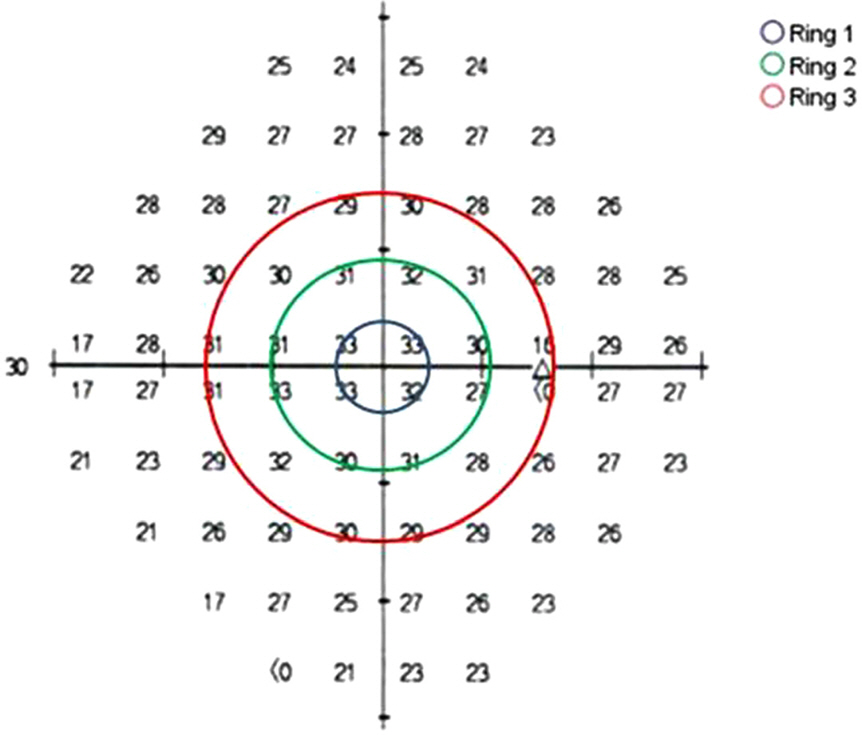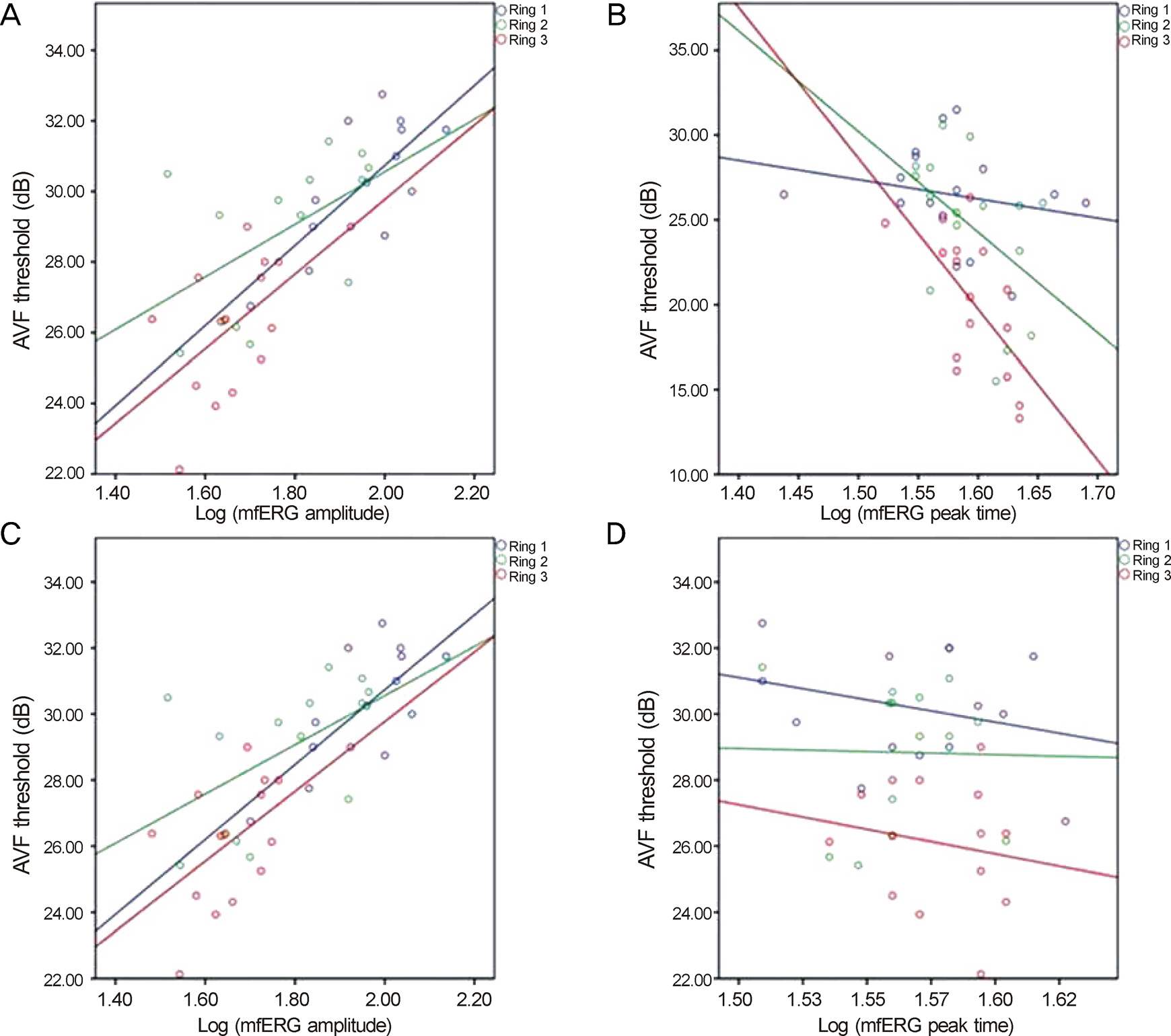J Korean Ophthalmol Soc.
2014 Feb;55(2):202-208. 10.3341/jkos.2014.55.2.202.
Correlation Between the Visual Field Test and Multifocal Electroretinogram in Patients with Diabetic Retinopathy
- Affiliations
-
- 1Department of Ophthalmology, Daegu Fatima Hospital, Daegu, Korea. vitreo-retina@hanmail.net
- KMID: 2218412
- DOI: http://doi.org/10.3341/jkos.2014.55.2.202
Abstract
- PURPOSE
To evaluate the macular function by a multifocal electroretinogram (mfERG) in patients with diabetic retinopathy (DR), and to assess the correlation between responses of mfERG and the threshold of the visual field test (VF).
METHODS
The records of patients with DR (16 eyes, 16 patients) and control subjects (14 eyes, 14 subjects) were retrospectively reviewed. mfERG and VF were divided into Ring 1, Ring 2 and Ring 3 at 6-degree intervals from the central macula. The correlation between the amplitude/peak time and the threshold of each ring was analyzed.
RESULTS
In patients with DR, the amplitude was decreased in all areas, the peak time was delayed in Ring 2 and the threshold was decreased in Rings 2 and 3, compared to control subjects. The amplitude of mfERG and the threshold of VF showed statistically significant positive correlations in Rings 2 and 3 (p < 0.05). The peak time of mfERG and the threshold of VF showed statistically significant negative correlations in Ring 3 (p < 0.05).
CONCLUSIONS
The threshold of VF was more significantly correlated with the amplitude than with the peak time of mfERG in patients with DR. mfERG and VF were useful tests to assess the macular function, and alteration of macular function was early detected because two tests were conducted at the same time.
Figure
Reference
-
References
1. Ola MS, Nawaz MI, Siddiquei MM. . Recent advances in un-derstanding the biochemical and molecular mechanism of diabetic retinopathy. J Diabetes Complications. 2012; 26:56–64.
Article2. Frank RN.Etiologic mechanisms in diabetic retinopathy. Ryan SJ, Retina Schachat AP., editors4th ed.Los Angeles: Mosby;2006. v. 2. chap. 66.3. Yoon JH, Kim MJ, Chin HS, Moon YS.Effect of PRP on visual acuity, visual field and subjective symptoms in very severe NPDR. J Korean Ophthalmol Soc. 2003; 44:2545–52.4. Lee BH, Cho YW.Quantitative analysis of diabetic macular edema by optical coherence tomography. J Korean Ophthalmol Soc. 2004; 45:1858–64.5. Ito H, Horii T, Nishijima K. . Association between fluorescein leakage and optical coherence tomographic characteristics of mi-croaneurysms in diabetic retinopathy. Retina. 2013; 33:732–9.
Article6. Hood DC.Assessing retinal function with the multifocal technique. Prog Retin Eye Res. 2000; 19:607–46.
Article7. Sutter EE, Dodsworth-Feldman B, Haegerstrom-Portnoy G.Simultaneous multifocal ERGs in diseased retina. Invest Ophthalmol Vis Sci. 1986; 27:301–2.8. Lung JC, Swann PG, Wong DS, Chan HH.Global flash multifocal electroretinogram: early detection of local functional changes and its correlations with optical coherence tomography and visual field tests in diabetic eyes. Doc Ophthalmol. 2012; 125:123–35.
Article9. Hood DC, Zhang X.Multifocal ERG and VEP responses and visu-al fields: comparing disease-related changes. Doc Ophthalmol. 2000; 100(2-3):115–37.10. Hood DC, Bach M, Brigell M. et al. International Society For Clinical Electrophysiology of Vision. ISCEV standard for clinical multifocal electroretinography (mfERG) (2011 edition). Doc Ophthalmol. 2012; 124:1–13.11. Harris A, Bingaman D, Ciulla TA, Martin B.Retinal and choroidal blood flow in health and disease. Ryan SJ, Schachat AP, editors. Retina. 4th ed.Los Angeles: Mosby;2006. v. 1:chap. 5.
Article12. Hood DC, Frishman LJ, Saszik S, Viswanathan S.Retinal origins of the primate multifocal ERG: implications for the human response. Invest Ophthalmol Vis Sci. 2002; 43:1673–85.13. Hood DC, Greenstein V, Frishman L. . Identifying inner retinal contributions to the human multifocal ERG. Vision Res. 1999; 39:2285–91.
Article14. Miller RF.The physiology and morphology of the vertebrate retina. Ryan SJ, Schachat AP, editors. Retina. 4th ed.Los Angeles: Mosby;2006. v. 1:chap. 9.
Article15. Kim SJ, Yu HG.The clinical applications of multifocal electro-retinogram in diabetic retinopathy. J Korean Ophthalmol Soc. 2004; 45:64–8.16. Kondo M, Miyake Y, Horiguchi M. . Clinical evaluation of multifocal electroretinogram. Invest Ophthalmol Vis Sci. 1995; 36:2146–50.17. Fine BS, Brucker AJ.Macular edema and cystoid macular edema. Am J Ophthalmol. 1981; 92:466–81.
Article18. Roth JA.Central visual field in diabetes. Br J Ophthalmol. 1969; 53:16–25.
Article19. Bengtsson B, Heijl A, Agardh E.Visual fields correlate better than visual acuity to severity of diabetic retinopathy. Diabetologia. 2005; 48:2494–500.
Article20. Federman JL, Lloyd J.Automated static perimetry to evaluate dia-betic retinopathy. Trans Am Ophthalmol Soc. 1984; 82:358–70.21. Pahor D.Automated static perimetry as a screening method for evaluation of retinal perfusion in diabetic retinopathy. Int Ophthalmol. 1997-1998; 21:305–9.22. Greenstein VC, Holopigian K, Hood DC. . The nature and ex-tent of retinal dysfunction associated with diabetic macular edema. Invest Ophthalmol Vis Sci. 2000; 41:3643–54.
- Full Text Links
- Actions
-
Cited
- CITED
-
- Close
- Share
- Similar articles
-
- The Clinical Applications of Multifocal Electroretinogram in Diabetic Retinopathy
- Effect of PRP on Visual Acuity, Visual Field and Subjective Symptoms in Very Severe NPDR
- Two Cases of Occult Macular Dystrophy in a Family
- The Effects of Calcium Dobesilate(Doxium) on the Electroretinogram in Patients with Diabetic Retinopathy
- The Influences of Arteriosclerosis on the Development and Progression of Diabetic Retinopathy




